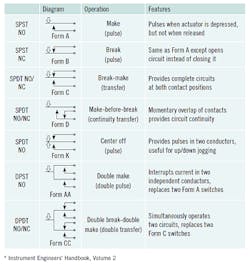Understanding switch configurations
This column is moderated by Béla Lipták, automation and safety consultant and editor of the Instrument and Automation Engineers' Handbook (IAEH). If you have an automation-related question for this column, write to [email protected].
Q: I learned very early in my career that contacts should be “Open to Alarm” and “Close on Status.” This term was used to eliminate the confusion of normally energized, de-energized, and shelf conditions. We always specify form C so we can use contact most appropriate for the application. This guideline avoided hazards from a broken wire. I would like to get your advice on what would be an excellent industrial reference to reinforce this with operators.
Hiten A. Dalal, P.E., PMP
Control & Automation Engineering team leader
[email protected]
A: Prompted by the important topic you brought up, I will not only answer the question, but I will give a brief overview of switches and switching in general. This subject is also discussed in my handbook, in Chapter 4.21 of the 4th edition of the 2nd Volume. Another fine discussion can be found at https://en.wikipedia.org/wiki/Switch.
As to the basics of switches and contacts, I’m sure you know that a manual electric switch consists of the switching contacts, an actuator to bring the contacts together, terminals to connect the contacts to the conductor of an electric circuit, the insulating mounting provisions, and the enclosure, either separate from or integral to the mounting for the contacts. The switch is operated by moving the contacts closer together until the applied voltage causes an electrostatic failure of the gap. The ensuing electron flow heats the cathode and cools the anode contact until molecular welding occurs, creating a continuous metallic path and completing the circuit. Contact resistance is a measure of the degree to which the insulating gas remains between the contacts, preventing welding over their entire bearing area. It is directly proportional to contact pressure.
You also know that switching action refers to the positions assumed by the contact in response to actuator motion. The two basic types include momentary action, which provides a contact closure and subsequent reopening with one actuation, and maintained action, which requires separate actuation to transfer the contacts from one extreme position to another and back. Other special switch types include:
- Mechanical bail, which allows operation of only one control at a time, physically inhibiting depression of others. Automobile radio selectors are a typical example.
- Electrical bail, which allows delayed or remote actuation, including sequencing of several controls. Solenoid operators frequently sequence rotary selectors or ganged push-buttons.
- Sequential action, which opens one contact set in a specified order in relation to other contacts in the same control system. This type may involve simultaneous operation of several contact sets and repeated opening and closing of one contact set during one actuation.
Now, coming to your specific question concerning contact arrangements, the number, type and arrangement of contacts and circuits determines the switching capacity. Table 1 lists the related terminology. The usual abbreviations used include:
Normally open (NO): The circuit is open (current does not flow) when the contacts are not actuated. Moving them to the other extreme position completes (closes) the circuit.
Normally closed (NC): The circuit is complete when the switch is not operated. Moving the contacts opens the circuits, interrupting current flow.
Number of poles (P): The number of conductors in which current will be simultaneously started or interrupted by one operation of the switch.
Number of throws (T): The number of positions at which the contacts will provide complete circuits. Since contacts usually have only two extreme positions, switches are either single-throw or double-throw.
As shown in Figure 1, Form C contacts are composed of a normally-closed contact pair and a normally-open contact pair that are operated by the same actuator device. Instead of the term Form C, industrial users often use the alternate name SPDP (single-pole, double-throw) for this configuration. There is a common electrical connection between a contact of each pair that results in only three connection terminals. These terminals are usually labelled as normally open, common, and normally closed (NO-C-NC). These contacts are quite frequently found in electrical switches and relays as their common contact element provides a mechanically economical method of providing a higher contact count.
Béla Lipták
[email protected]
A: We always used Form C relays for all applications, and used both contacts for the logic. The result was that a 1-0 or 0-1 were the only acceptable readings: 1-1 or 0-0 always indicated a fault (contact or wiring). We didn’t have a standard for a difference between alarm and status. I realize that this makes logic diagramming and programming a little more difficult, but reliability is far more important.
Dick Caro , CEO, CMC Associates
ISA Life Fellow
[email protected]
A: NO, NC refer to the relay being de-energized or powered off. So, to have “open to alarm” condition, the NO contact would be used for this. A loss of power would look like the alarm condition. A good reference is https://en.wikipedia.org/wiki/Electrical_contacts.
Bruce B. Burton
R&D program manager
[email protected]
A: NO and NC are the fundamental blocks of understanding any logic, be it soft or hardware. Normal condition is defined as energized condition and when plant/equipment/machine is running in normal condition, logic is true.
NC means normally-closed contact. NO means normally-open contact. When the relay coil is de-energized, NC contact becomes open, and NO contact closes.
For alert and emergency shutdown (ESD) logic, a break-to-alarm philosophy is employed so that during an emergency, NC contact will become open and trip/provide alarm. Normally, high (H) and high high (HH) switches (level, pressure, etc) are designed as NC. Low (L) and low low (LL) contacts are defined as NO. You can call me at +971504874184 for a detailed discussion.
Debasis Guha
Deputy manager C&I, Petrofac
[email protected]
A: This is very good observation, because this is not a well understood issue in many industrial and medical applications. Plus, there are unique issues when working with fiber optic sensor/switch systems. Fiber optic sensor systems consist of the sensor, fiber optic link and controller (which incorporates a relay providing dry contacts). Sensors typically use two fibers so the sensor, link and controller form a continuous optical loop when connected. The two states are referred to as MonitoringState and EmergencyState. The relay contacts (NO or NC) are used as is appropriate to the application. A microswitch plunger is mechanically triggered to the opposite state (moves an internal mirror so that the optical circuit is broken).
In the normal monitoring state, the optical circuit is ON and continuity exists between the E-stop/switch and corresponding controller. With the E-stop in reset position, if the microswitch requires plunger DOWN, then NO order option is chosen. If the microswitch requires plunger UP, then NC order option is chosen.
The emergency state is triggered by power loss, fiber optic link damaged, fiber optic disconnection or E-stop activated (plunger down breaks the internal optical circuit).
Dennis Horwitz
Micronor Inc.
[email protected]


